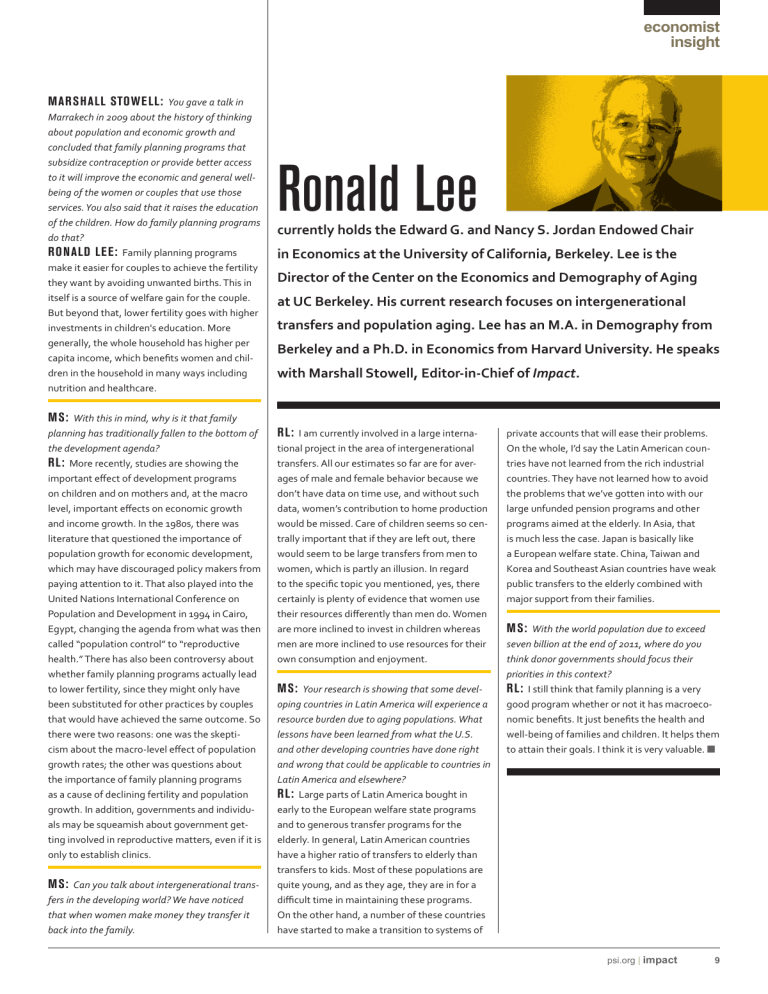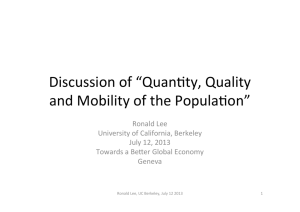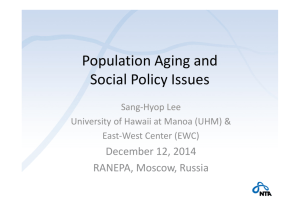Ronald Lee - National Transfer Accounts

economist insight
MARSHALL STOWELL: You gave a talk in
Marrakech in 2009 about the history of thinking about population and economic growth and concluded that family planning programs that subsidize contraception or provide better access to it will improve the economic and general wellbeing of the women or couples that use those services. You also said that it raises the education of the children. How do family planning programs do that?
RONALD LEE: Family planning programs make it easier for couples to achieve the fertility they want by avoiding unwanted births. This in itself is a source of welfare gain for the couple.
But beyond that, lower fertility goes with higher investments in children's education. More generally, the whole household has higher per capita income, which benefits women and children in the household in many ways including nutrition and healthcare.
Ronald Lee
currently holds the Edward G. and Nancy S. Jordan Endowed Chair in Economics at the University of California, Berkeley. Lee is the
Director of the Center on the Economics and Demography of Aging at UC Berkeley. His current research focuses on intergenerational transfers and population aging. Lee has an M.A. in Demography from
Berkeley and a Ph.D. in Economics from Harvard University. He speaks with Marshall Stowell, Editor-in-Chief of Impact .
MS: With this in mind, why is it that family planning has traditionally fallen to the bottom of the development agenda?
RL: More recently, studies are showing the important effect of development programs on children and on mothers and, at the macro level, important effects on economic growth and income growth. In the 1980s, there was literature that questioned the importance of population growth for economic development, which may have discouraged policy makers from paying attention to it. That also played into the
United Nations International Conference on
Population and Development in 1994 in Cairo,
Egypt, changing the agenda from what was then called “population control” to “reproductive health.” There has also been controversy about whether family planning programs actually lead to lower fertility, since they might only have been substituted for other practices by couples that would have achieved the same outcome. So there were two reasons: one was the skepticism about the macro-level effect of population growth rates; the other was questions about the importance of family planning programs as a cause of declining fertility and population growth. In addition, governments and individuals may be squeamish about government getting involved in reproductive matters, even if it is only to establish clinics.
MS: Can you talk about intergenerational transfers in the developing world? We have noticed that when women make money they transfer it back into the family.
RL: I am currently involved in a large international project in the area of intergenerational transfers. All our estimates so far are for averages of male and female behavior because we don’t have data on time use, and without such data, women’s contribution to home production would be missed. Care of children seems so centrally important that if they are left out, there would seem to be large transfers from men to women, which is partly an illusion. In regard to the specific topic you mentioned, yes, there certainly is plenty of evidence that women use their resources differently than men do. Women are more inclined to invest in children whereas men are more inclined to use resources for their own consumption and enjoyment.
MS: Your research is showing that some developing countries in Latin America will experience a resource burden due to aging populations. What lessons have been learned from what the U.S. and other developing countries have done right and wrong that could be applicable to countries in
Latin America and elsewhere?
RL: Large parts of Latin America bought in early to the European welfare state programs and to generous transfer programs for the elderly. In general, Latin American countries have a higher ratio of transfers to elderly than transfers to kids. Most of these populations are quite young, and as they age, they are in for a difficult time in maintaining these programs.
On the other hand, a number of these countries have started to make a transition to systems of private accounts that will ease their problems.
On the whole, I’d say the Latin American countries have not learned from the rich industrial countries. They have not learned how to avoid the problems that we’ve gotten into with our large unfunded pension programs and other programs aimed at the elderly. In Asia, that is much less the case. Japan is basically like a European welfare state. China, Taiwan and
Korea and Southeast Asian countries have weak public transfers to the elderly combined with major support from their families.
MS: With the world population due to exceed seven billion at the end of 2011, where do you think donor governments should focus their priorities in this context?
RL: I still think that family planning is a very good program whether or not it has macroeconomic benefits. It just benefits the health and well-being of families and children. It helps them to attain their goals. I think it is very valuable. n psi.org
| impact 9











